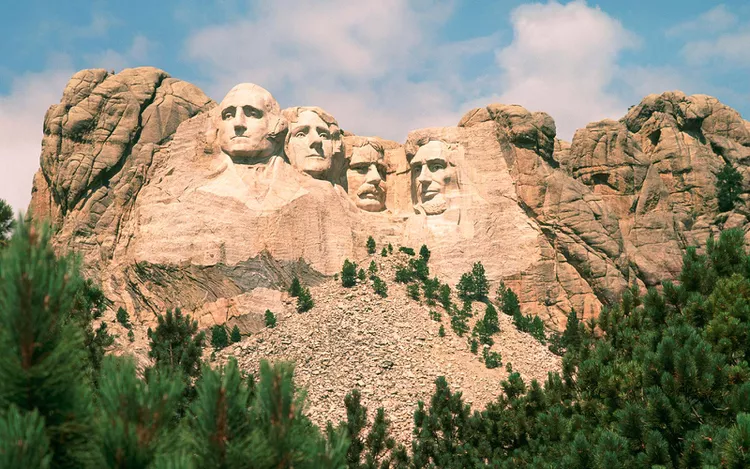Summary:
Hidden chambers, optical illusions, and even a little-known secret concerning the King of Rock and Roll.
Fact checked by Elizabeth MacLennan
History of Mount Rushmore
South Dakota’s Mount Rushmore is one of the most iconic symbols of the United States, on par with the Liberty Bell and the Statue of Liberty. First proposed by South Dakota State Historian Doane Robinson in 1923, Mount Rushmore didn’t reach its final form until 1941—prematurely halted by the death of the monument’s sculptor, Gutzon Borglum. Carving began in 1927, and nearly 400 men and women worked on the project which involved climbing 700 stairs every day and using dynamite to blast through rock, although the construction saw zero fatalities. The featured four presidents were chosen by Borglum because he believed they “represented the most important events in the history of the United States.”
The colossal, 60-foot profiles of George Washington, Thomas Jefferson, Theodore Roosevelt, and Abraham Lincoln are so instantly recognizable, they’ve been spoofed in commercials, used as film backdrops, and reproduced in all sizes and forms, including a giant construction at Legoland.
But for all of Mount Rushmore’s widespread fame (and over 2 million annual visitors), it also possesses a deep history and a long list of little-known facts that may surprise even the most well-read history buff.
:max_bytes(150000):strip_icc():format(webp)/mount-rushmore-unique-facts-history_final-df00d20754b04d819d7ef203bd261e5a.jpg)
Funding and Presidential Involvement
When Mount Rushmore was conceived in the late 1920s and the project needed funding, President Calvin Coolidge had an auspicious summer vacation in the Black Hills. His trip coincided with a planned formal dedication ceremony of the mountain by Borglum. Locals employed wildly creative means to endear themselves to the president, including gifts like a ten-gallon hat. Once, a plane air-dropped a wreath of flowers at his lodge, and even a creek was stocked with fattened trout from a hatchery so the president could have an easy time fishing. Ultimately, President Coolidge attended the dedication ceremony and promised federal funding for the project.
Optical Illusions and Sculptural Design
Interestingly, only the pince-nez (but neither the lenses nor the ear pieces) was carved onto President Roosevelt’s face along with ridges on the upper cheeks. From afar, the commander-in-chief appears to don a pair of spectacles. This represents an impressive optical illusion and sculptural stunt.
:max_bytes(150000):strip_icc():format(webp)/construction-mount-rushmore-south-dakota-RUSHMORE0317-8048a8c4051847c8b48945fc3222582b.jpg)
Hidden Chamber Behind Lincoln’s Head
To accompany the faces, Borglum envisioned a repository with an entrance crowned by a bronze eagle, accessible via a grand staircase. The interiors were meant to be adorned with friezes, vaulted ceilings, busts, and bronze-and-glass cabinets that housed artifacts central to American democracy. The construction achieved only a partial completion—a tunnel was blasted into the canyon—before it was abandoned. Though the unfinished Hall of Records, cut into the rock behind President Lincoln’s head, remains off-limits to visitors, it possesses a titanium vault with porcelain panels outlining milestones in U.S. history.
Attempts to Add a Fifth Face
Women’s rights activist Rose Arnold Powell led a relentless campaign to get Susan B. Anthony’s visage added to the mountain. Simultaneously, conservatives drove the “Reagan on Rushmore” or “Ron on the Rocks” movement to memorialize the 40th president’s legacy. There have even been attempts to add Elvis Presley’s slicked-back likeness to the Black Hills.
Best Viewing Locations
While it’s true that the head-on views from the Grand View Terrace are spectacular and unobstructed, the best experiences often come from the less-traveled routes. Walking the often-bypassed loop around the base of the mountain allows a closer view of the faces at various angles, and you may even spot a Rocky Mountain goat or a mule deer along the trail.
Historical and Cultural Significance
Mount Rushmore has also been a site of continued controversy since its conception. The area was designated Sioux territory by the Fort Laramie Treaty of 1868, and the Black Hills hold historical, spiritual, and cultural significance to the area’s tribal nations. For Native American protesters, particularly active in the 1970s, Mount Rushmore serves as a painful reminder of broken treaties and a history of mistreatment. This sentiment is exacerbated by the men represented on the monument.
:max_bytes(150000):strip_icc():format(webp)/sioux-mount-rushmore-south-dakota-RUSHMORE0317-389410ef10144af8af898f12b3e70589.jpg)
Unfinished Nature of the Monument
If there’s something raw and rugged about Mount Rushmore, it’s due to the fact that it’s far from a finished masterpiece. Aside from a final brush-up by Borglum’s son, Lincoln, construction halted after the original sculptor’s death. The model was meant to depict the heads-of-state down to their waists; however, today you can barely make out Washington’s coat collar and Lincoln’s ear, shoulder, and a fourth knuckle were never chiseled to completion.
Navigational Issues with Google Maps
If you’re using Google Maps to locate this national landmark, be very specific. General searches for Mount Rushmore can often send travelers astray. For instance, if you find yourself at a Methodist campground called Storm Mountain Center, you’re about 12 miles away from the memorial.




